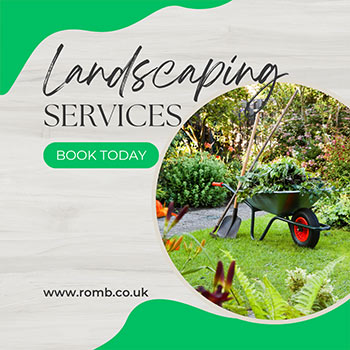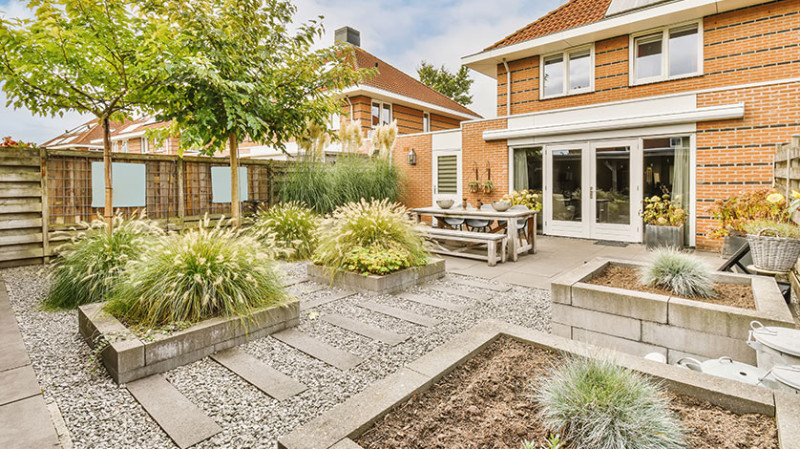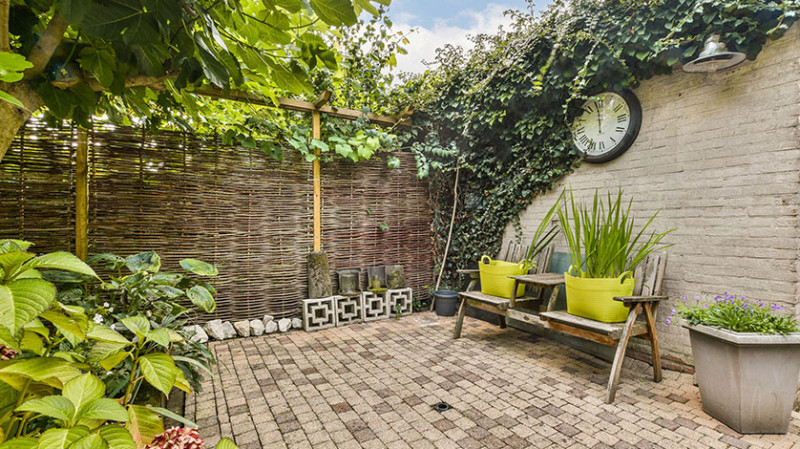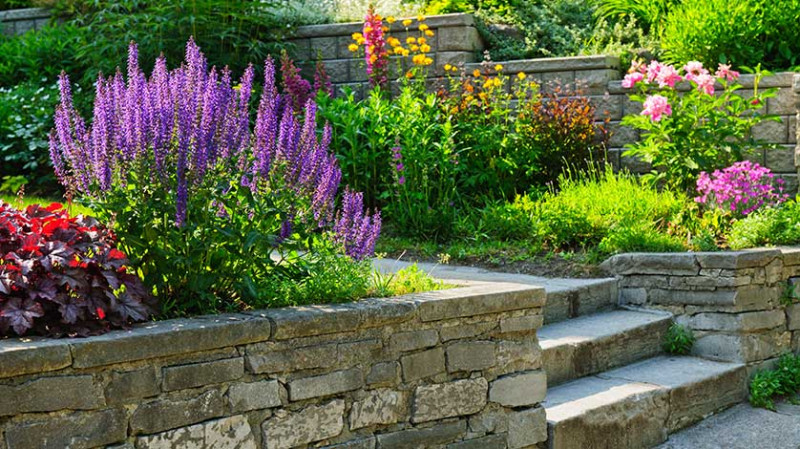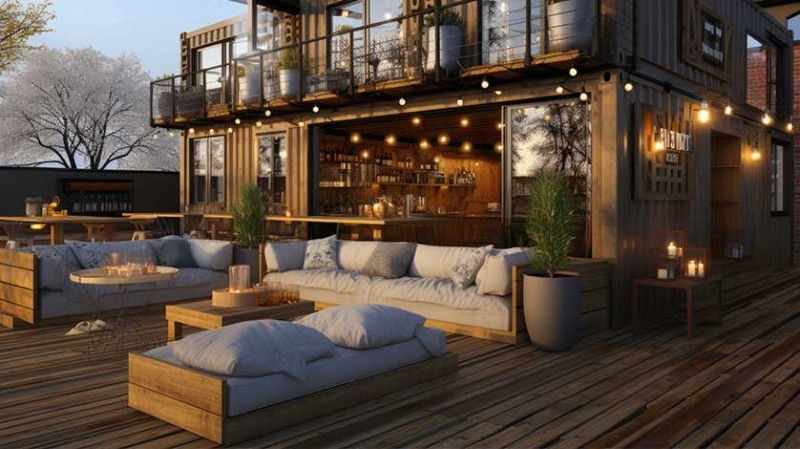
Maintaining a lush green lawn can be time-consuming, expensive, and often impractical — especially in the unpredictable British climate. That’s why more homeowners, designers, and DIY lovers are ditching grass altogether for stylish, low-maintenance alternatives. Whether you’re working with a tiny patio in London or a spacious suburban backyard in Manchester, these 22 cheap no grass backyard ideas will inspire you to create a beautiful outdoor space without the fuss of mowing, watering, or weeding turf. Let’s explore your options for transforming your garden into an inviting, functional sanctuary — all on a budget.
1. Gravel Garden
Gravel is one of the most cost-effective materials you can use to replace grass. It’s incredibly low-maintenance, drains well, and gives your garden a sleek, modern appearance. For added texture and colour variation, consider mixing shades of gravel or outlining paths and seating areas with larger stones.
Gravel also works perfectly in combination with potted plants, ornamental grasses, and timber decking to create a Mediterranean or contemporary look. To prevent weed growth, lay weed-suppressant membrane beneath the gravel.
A gravel garden looks beautiful beside whitewashed walls, upcycled wood furniture, or terracotta planters. It's durable and stands up well against rainy UK weather, making it a viable long-term replacement to turf.
2. Artificial Turf
When you love the look of grass but not the maintenance, artificial turf is the ultimate compromise. It’s an upfront investment, but the savings in water, time, and lawn care equipment quickly pay off.
Artificial grass has come a long way in recent years — with realistic textures, colour mixes, and better drainage systems suited for wet British conditions. It's also pet- and child-friendly, making it an ideal solution for family homes.
You can use artificial turf across an entire yard or just in specific zones to soften hardscapes or framing areas like under pergolas, around fire pits or as walkways.
3. Decking
Timber or composite decking gives your garden a clean, elevated feel — perfect for outdoor dining, lounging, or entertaining. Treated softwoods like pine are affordable and accessible, while composite boards require less maintenance.
Decking is a great addition for sloped gardens or areas where grass struggles to grow. It provides a functional, year-round surface and works beautifully with planters, lights, and outdoor furniture.
To ensure longevity in the wetter regions of the UK, use anti-slip treatments and consider installing a drainage system beneath the deck base.
4. Paving and Stone Patios
Paving is a classic choice for those who want a clean, structured finish. It’s ideal for everything from modern courtyards to quaint cottage gardens. With a wide range of materials such as sandstone, limestone, slate or affordable concrete slabs — there’s a paving option to suit every taste and budget.
For a sustainable, low-cost upgrade, consider using reclaimed pavers or bricks from architectural salvage yards or online marketplaces like Facebook Marketplace or Gumtree. Mixing materials and patterns like herringbone or grid styles can add personality to your garden without blowing the budget.
Keep paving weed-free by filling gaps with polymeric sand or moss for garden charm.
5. Raised Garden Beds
Turn a bland backyard into a productive, eco-friendly retreat with raised garden beds. They’re easier to manage than ground-level planting and great for improving soil conditions and drainage.
Raised beds can be constructed using reclaimed timber, old railway sleepers, or even stone gabions for rustic charm. Plant herbs, veggies, or shrubs for a lush feel — no grass required.
Add gravel or bark mulch around the beds to maintain tidy walkways and complement the low-maintenance design.
6. Mulch and Bark Landscaping
Mulch and bark chips are among the most budget-friendly and eco-conscious solutions for ground cover. These organic materials suppress weeds, retain moisture for plants, and break down slowly to enrich the soil.
Bark paths create a woodland or rustic aesthetic and work well alongside raised beds or forest gardens. Choose locally sourced bark for lower costs and a smaller carbon footprint.
Combine bark with stepping stones or natural log slices for charming British countryside appeal — perfect in shaded gardens or under tree canopies.
7. Outdoor Rug Zones
If you have a deck or paved area, layering with colourful outdoor rugs instantly adds comfort and personality. Rugs can define ‘rooms’ in the garden, such as a reading nook, yoga space or alfresco coffee corner.
Look for weather-resistant and UV-stable polypropylene rugs available from UK home improvement stores like B&Q or Wickes. Many are budget-friendly and easy to clean with a hose down or light scrub.
This option suits renters or those who want flexibility, as rugs can be easily swapped with seasonal tastes.
8. Concrete Slabs with Decorative Stones
Concrete doesn’t have to feel industrial or cold. Pairing concrete slabs with decorative gravel or pebbles between gaps creates a modern and artistic finish — often seen in high-end urban landscapes.
This solution is highly durable and weather-resistant — excellent for high-traffic areas or narrow side return gardens commonly found in terraced homes.
Install lighting between the slabs or add low planting between stones for contrast and softness.
9. Vertical Gardens and Green Walls
No space? No problem. Vertical gardens let you grow upwards rather than outwards, ideal for small courtyards or balconies.
Use wall-mounted planters, trellises, or pallet-style frames to grow herbs, succulents, or trailing vines like ivy or clematis. It adds greenery without any need for turf.
This DIY-friendly approach also works great along unsightly fences or bare brick walls, adding life and texture.
10. Garden Edging with Pebbles
Make your lawn-free garden more attractive by defining different sections using decorative pebble edging. It’s an affordable way to frame planting beds, pathways or patios with subtle texture and contrast.
Available in a range of colours — from creamy whites to dramatic greys — pebbles are very versatile. Consider creating spiral or mosaic designs for added creativity.
Pair with solar lights for instant curb appeal, especially front gardens or narrow access paths.
11. Container Gardening
Container gardens offer colour, foliage, and fragrance — all without planting directly in the ground. Place grouped planters of different heights and materials to create structure and visual interest in corners or patios.
This gardening method is ideal for renters or those with limited mobility. Use pots made from recycled plastic, ceramics, or lightweight terracotta to balance budget and style.
Mix evergreens, herbs, and flowering annuals to keep the space vibrant year-round.
12. Pergola or Gazebo Feature
Installing a pergola or gazebo transforms a plain, grassless yard into a functional outdoor room. It provides shade, shelter, and an architectural focal point. Choose budget kits from home improvement stores or DIY your own with timber and available online plans.
You can hang plants, fairy lights or curtains from the frame for additional ambience. Add a firepit or seating below for a cosy gathering spot.
This is a great solution for extending your living space without touching the turf.
13. Japanese Zen Garden
Why not invite serenity into your garden with a Japanese-inspired Zen layout? Use raked gravel, minimalist rocks, simple pathways and low ground covers like moss or ornamental grasses to evoke calm and simplicity.
It’s a meditative, calming alternative to traditional back gardens and requires little ongoing maintenance. Feature bamboo fencing, water bowls or lanterns for authentic touches.
14. Reclaimed Brick Paths
Brick paths add vintage charm and can be made from salvaged materials found in used building supply stores. They look gorgeous paired with lush hedge borders or climbing roses.
Use a running bond or basketweave pattern to add character. Reclaimed bricks are often cheaper and sustainably sourced — a win for eco-minded UK homeowners.
15. Outdoor Living Room
If you primarily use your garden for relaxing or socialising, consider swapping grass for an outdoor lounge setup. Think modular furniture, shade sails, soft textiles, lanterns, and planters to soften the look.
Pave the area with concrete slabs, decking, or compressed gravel to keep it low-maintenance and weatherproof.
16. Stepping Stone Paths
Stepping stones are affordable, functional and attractive — great for navigating gardens without damaging planting zones. Space them out over gravel, mulch or low groundcovers for a layered look.
You can make stepping stones from cut slate, poured concrete, or upcycled tiles — leaving room for creativity and customisation.
17. Painted Concrete
If your garden already has concrete, add colour and personality with specialist outdoor concrete paints or stencil designs. It’s far cheaper than replacing slabs — and can be transformed in a weekend.
This is a perfect option for inner-city homes or courtyard gardens in need of visual lift.
18. Living Roof Sheds
If you have a shed or garden office, transform its roof into a green feature. Sedum mats or wildflower roofs not only look stunning, but also support biodiversity and improve insulation.
These installations may qualify for green incentives in the UK and reduce stormwater runoff, too.
19. DIY Gabion Walls
Gabion baskets filled with stones or recycled materials can form raised beds, seating, or retaining walls. They’re easy to build, sustainable, and offer a rugged, industrial appeal often seen in modern landscaping.
20. Dry River Bed Landscaping
Add a flowing design element by creating a dry riverbed using pebbles, cobbles and driftwood. This design is low in cost, long-lasting and works particularly well in sloped gardens to guide rainwater runoff.
21. Backyard Cinema Space
Turn a small paved or decked garden into a cosy cinema with a projector and retractable screen. Layer with beanbags, blankets, string lights, and bucket popcorn for budget-friendly magic under the stars.
22. Herb Spiral
A herb spiral is a beautiful, functional alternative to grass — perfect for culinary enthusiasts. Build it with reclaimed bricks, stones or logs in a spiral design, planting Mediterranean herbs towards the top and moisture-loving varieties at the base.
This design maximises vertical space and provides year-round greens with little to no upkeep.
Final Thoughts
You don’t need a lush lawn to enjoy a beautiful, functional garden. These 22 affordable no-grass ideas show you how to create a low-maintenance outdoor space that reflects your style, supports your lifestyle, and stands up to the UK weather.
So roll up your sleeves, grab your tools, and transform your garden into a haven — without a mower in sight.
